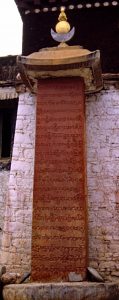བསམ་ཡས། རྡོ་རིང་།

[1] The seats for the Triple Gem established in the temples of Rasa and Brag Mar and other places and the practice of the Buddha dharma shall never be rejected and never be destroyed.
[7] And whatever necessities were provided (for the Triple Gem in these temples), from that nothing shall be deducted or abrogated.
[9] From this time forward, a resolution shall be made in accord with this by the sovereign father and (his) son in every succeeding generation of the dynasty whatsoever.
[12] Pursuant to that, so that subversions of spoken vows shall neither arise nor be acted on, everyone–sovereign father, son and noble ministers– swore solemn oaths and made pledges, invoking as witnesses the gods of this world and beyond this world, and also all non-human spirits.
[20] A detailed text of the proclamation exists separately.
Other versions
been provided shall not be diminished or reduced. From now onward each generation of the btsan-po fathers and sons, shall make a vow in this way. And in order that there shall be no detraction from that oath and that it shall not be changed, the supra-mundane gods, the gods of the world, and the spirits are all invokes as witnesses. The bstan-po, father and son, ruler and ministers all have sworn. A detailed account of the edict exists separately.